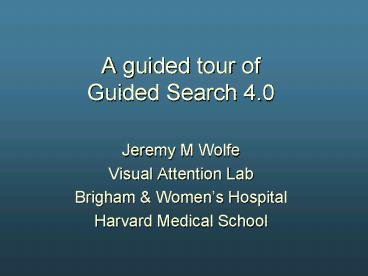A guided tour of Guided Search 4'0
1 / 44
Title:
A guided tour of Guided Search 4'0
Description:
A guided tour of. Guided Search 4.0. Jeremy M Wolfe. Visual Attention Lab. Brigham & Women's Hospital. Harvard Medical School. What are we trying to explain? ... –
Number of Views:188
Avg rating:3.0/5.0
Title: A guided tour of Guided Search 4'0
1
A guided tour ofGuided Search 4.0
- Jeremy M Wolfe
- Visual Attention Lab
- Brigham Womens Hospital
- Harvard Medical School
2
What are we trying to explain?
Find the raspberry
3
What are we trying to explain?
Find the queen
4
What are we trying to explain?
Find the tumor
5
What are we trying to explain?
Where is the cancer? 3-4 CM BELOW THE TOP
(NORTH) AND ABOUT 2-3 CM WEST OF THE PECTORAL
MUSCLE SHADOW. IT'S A SUBTLE NODULAR DENSITY.
Find the tumor
6
What are we trying to explain?
Where is the cancer in 9? 3-4 CM BELOW THE TOP
(NORTH) AND ABOUT 2-3 CM WEST OF THE PECTORAL
MUSCLE SHADOW. IT'S A SUBTLE NODULAR DENSITY.
Yes, well, subtle is a good word!
7
What are we trying to explain?
Find the threat
8
What are we trying to explainin the lab?
Some tasks are easy
Find the 5
9
What are we trying to explain?
Some tasks are hard
Find the 5
10
What are we trying to explain?
Some tasks are in-between
Find the green 5
11
This is not a bimodal distribution
Wolfe, J. M. (1998). What do 1,000,000 trials
tell us about visual search? Psychological
Science, 9(1), 33-39.
12
Different tasks yield different slopes
But slope is not a simple diagnostic for type.
13
There is a continuum of searches
14
The Goals of Guided Search (and this talk)
1) To model the range of human search behavior.
2) To include more than just mean RTs for
target-present trials.
3) To avoid an excess of special pleading and
deus ex machina theorizing.
15
How do we do it?
There is a stimulus
16
Local salience is computed
17
It is local differences that create bottom-up
salience
18
red
steep
A limited set of coarse, categorical features are
computed
19
Coarse?
Find the orientation oddballs.
20
Categorical? Find (10 deg left tilt)
21
Why?
T-10, D50,-50
T-10, D30,-70
Categorically steep
Not categorical
22
A weighted sum creates an activation map.
23
The activation map All else being equal, local
salience will be weighted heavily and will
attract attention (bottom-up).
24
Bottom-up salience is not enough (Hence,
activation not salience map)
Find the target
25
Top-down guidance Give weight to what you want
Find the green verticals
26
An activation map note It is hard to set the
weight on bottom-up salience to zero.
Find the green verticals
27
The activation map guides re-entrant attentional
selection of objects
28
Meaning that you do not see the output of the
activation map.
29
Lets elaborate on that a bit.
Guided Search is a two-stage model
First Stage
30
The core idea of Guided Search
?
?
?
?
?
?
?
?
First Stage
Second Stage
31
This is a low-threshold SDT model (sort of)
?
?
?
?
?
?
?
?
First Stage
Second Stage
32
Followed by a high-threshold, binding stage
?
?
?
?
?
?
?
?
First Stage
Second Stage
33
What do we know about capacity limitations in
search?
34
The rate of processing can be 20-30 items per
second
?
?
?
?
?
?
?
?
Based on slopes of RT x set size functions
35
But each item takes 100 - several hundred msec to
process
Based on attentional dwell time experiments (e.g.
AB)
G
H
T
3
R
Y
6
F
J
T1
T2
36
We infer that more than one item can be in this
pipeline at on time.
Based on attentional dwell time experiments (e.g.
AB)
G
H
T
3
R
Y
6
F
J
T1
T2
37
We model this as an asynchronous diffusion
process.
A few hundred msec
Serial selection through the bottleneck.
N items can accumulate information at any one time
38
Diffusion models have some nice features.
Geometry produces these skewed RT distributions
Suppose this is the average rate of information
accumulation
And suppose that rate is variable and normally
distributed.
39
Human data look like this, too.
Gamma distributions fit well.
This is part of a big data set on our website
http/search.bwh.harvard.edu
40
A vexing problem
Find the 5
41
Ummthere is no 5
How do you know when to stop?
42
We know you are not marking every reject
How do you know when to stop?
43
The number marked as rejected is small (4 ish at
mostmaybe 0)
How do you know when to stop?
44
Some sort of adaptive process is at work
correct
correct
correct
error
error
The details of the quitting threshold are tricky































